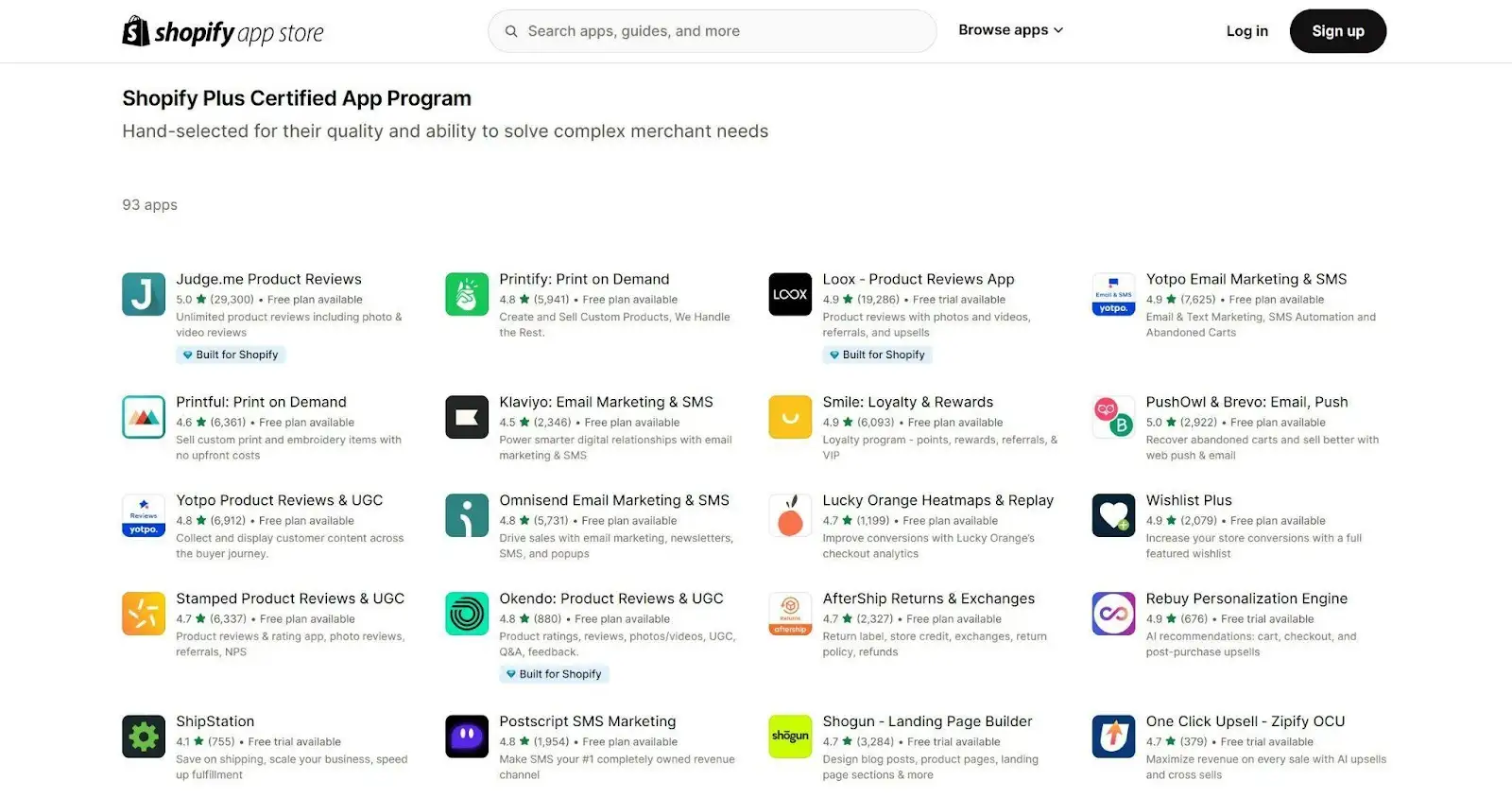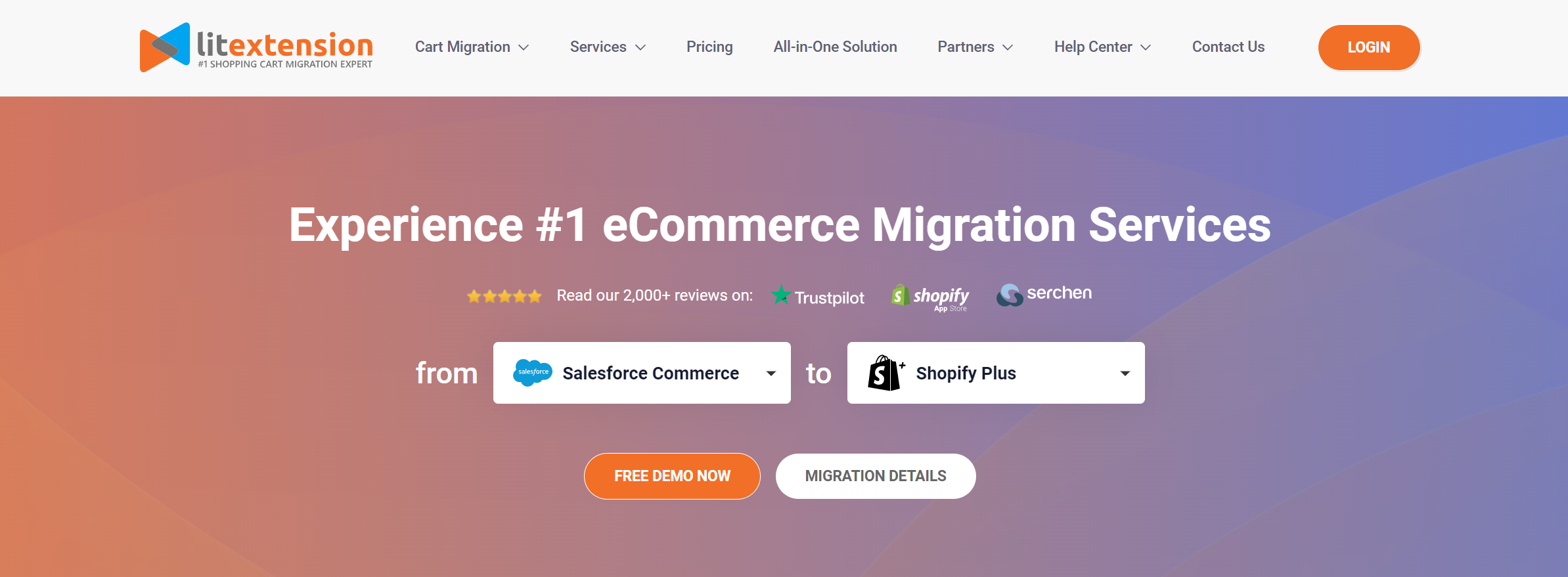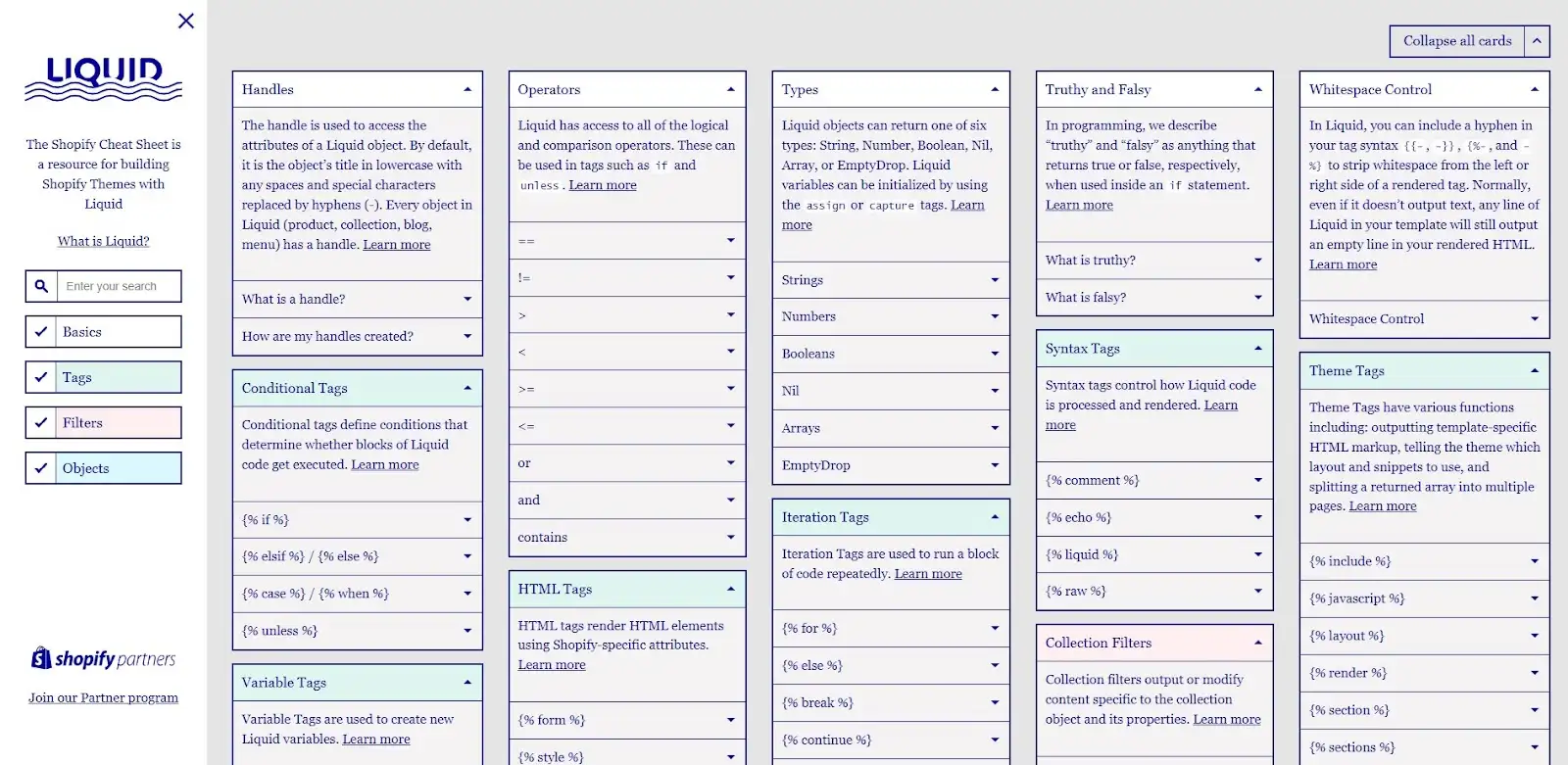Considering a Salesforce Commerce Cloud to Shopify Plus migration? You're not alone. From my observations, many online merchants (especially enterprises and B2B businesses) are migrating to Shopify Plus to take advantage of its powerful features and scalability.
Just like any big move, careful planning is the key to a successful migration. In this guide, I will walk you through seven essential steps to switch from Salesforce Commerce Cloud to Shopify Plus, including:
#1. Determine the budget for your migration
#2. Estimate the migration timeline
#3. Review your tech stack
#4. Find an alternative for your Shopify Plus app
#5. Prepare data for the migration
#6. Migrate from Salesforce Commerce Cloud to Shopify Plus
#7. Personalize your new Shopify Plus store
Salesforce Commerce Cloud to Shopify Plus Migration Guide in 7 Steps
Step 1. Determine the cost of your migration
Moving from Salesforce Commerce Cloud to Shopify Plus is a big step. It is essential to know the costs involved in this process. This knowledge is the key to setting a clear budget and ensuring a smooth migration to Shopify Plus.
In this section, we’ll break down all the costs involved in this Shopify Plus migration from Salesforce Commerce Cloud.
Shopify Plus fees
This is the first thing you need to take into consideration since you will operate all your business activities here. The monthly Shopify Plus pricing starts from $2,300 if you sign a 3-year-term contract. Nonetheless, if this contract is annually renewed, the starting price will be $2,500 per month.

However, please note that these Shopify Plus fees aren’t fixed numbers. This platform takes a 0.35% or 0.4% cut of your total GMV, depending on your contract terms. For example, if you make $1M per month & sign a 0.35% contract with them, your monthly pricing for Shopify Plus will be $3,500.
Besides, when calculating the Shopify Plus pricing, you’ll need to consider the monthly subscription fee for your integrated apps. Shopify Plus provides a suite of nearly 100 extensions in their Shopify Plus Certified App Program to further enhance your store’s functions. Each app comes with different pricing tiers, so don’t forget to count them in when estimating your budget.

Cost for migration service
When it seems impossible to migrate from Salesforce Commerce Cloud to Shopify Plus manually, hiring a migration service is an optimal solution. With their extensive expertise in the market, they can help you swiftly transfer data to the new platform with minimal downtime and errors.
Please note that there isn’t an exact formula for calculating the cost of migration service. It largely depends on which solution you choose, how complex your data migration is, and whether you have any requirements that need to be met. These factors will add up to your Salesforce Commerce Cloud to Shopify Plus migration budget, so you’ll need to consider this carefully.
🔔 Bonus Tips
Throughout my years of experience working with hundreds of merchants around the world, my advice is that: Don’t compromise anything for a lower migration cost. The service you choose should be seasoned experts in the field so that they can foresee any potential problems and get rid of them. Besides, they should be able to provide a tailored migration solution to meet all your special requests during the process.

Cost for Shopify Plus development service
Now that you’ve migrated from Salesforce Commerce Cloud to Shopify Plus, what comes next? Setting up your new store and ready for business.
If you decide to employ a Shopify Plus development service to optimize your storefront, this is another cost you need to consider.
There are several aspects that can affect this fee, including:
- The complexity of the project: If your development project involves lots of custom apps and complex functionalities, the price for Shopify Plus migration service might be higher.
- The expertise of your development partner: The experience and expertise of your chosen development service is also an influence to this price. Agencies with a proven track record in Shopify Plus development typically command higher rates due to their specialized knowledge.
- Ongoing maintenance and support: In case you have other requirements that arise after the SLA (Service-Level Agreement), some services might charge an extra fee for these newly incurred requests. Therefore, don’t forget to consider these unexpected events when calculating the total cost for your Salesforce Commerce Cloud to Shopify Plus migration.
Other potential costs
These costs are not always mandatory; however, they can still add up to your total Salesforce Commerce Cloud to Shopify migration expense. So, my advice is that you still need to consider these costs when calculating to avoid overbudgeting.
#1 Cost for staff training
Salesforce Commerce Cloud and Shopify Plus have very different interfaces and functionalities. As a result, your business might face difficulties navigating the new platform.
In this case, your team will need some training sessions to use Shopify Plus effectively. This could involve online courses, workshops, or even hiring a Shopify Plus specialist to provide in-house training.
#2 Cost for marketing activities
Sometimes, a platform migration can lead to temporary disruptions in your marketing efforts. You might need to adjust existing campaigns or create new ones to ensure a seamless transition for your customers. This could include updating website content, re-running social media ads, or sending out email blasts to inform customers about the changes.
#3 Cost for security measures
Though Shopify Plus itself is a secure solution, I believe that investing in security could never go wrong. You might consider implementing additional measures like fraud prevention tools or penetration testing to further protect your store after the Salesforce Commerce Cloud to Shopify Plus migration.
Step 2. Estimate migration time
Now that your budget is allocated, it’s time to think about the migration timeline. From my experience, without a clear timeline, you risk delays, budget blowouts, and a whole lot of stress.
From my experience working with hundreds of projects, I have noticed that Salesforce Commerce Cloud to Shopify Plus migration is normally divided into three main stages.
Step 1. Review and backup (1-3 weeks)
Before taking the first step towards your shiny new website, you need to thoroughly understand your existing one. This stage is all about information gathering and safeguarding your digital assets, including:
- Content audit: At this step, you’ll need to analyze your existing content, identify top performers, and flag outdated or irrelevant material. In short, the main purpose of this auditing process is to decide what stays, what goes, and what needs a refresh.
- Technical SEO audit: Crawl your site to unearth broken links, analyze existing redirects, and assess your site's overall technical health. This action ensures you only bring along high-quality assets and leave behind broken ones.
- Function review: Identify the essential features you are currently using. It is also a chance to determine whether you need an alternative app for that function on Shopify Plus or you could make use of an existing one.
- Data backup: This will be your savior when things go wrong. Make sure to back up everything—your website files, database, and any related assets—to have a rewind version in case of data loss during the migration.
Step 2. Website development (3-5 Weeks)
With a clear picture of your existing website and a secure backup in hand, it's time to turn your vision into reality. The Shopify Plus development process involves:
- New store setup: First thing first, don’t forget to set up your store. It will be the “foundation” to your new website, so make sure to take your time with it.
- Theme design: This is where your site's look and feel come to life. Choose a theme that aligns with your brand and customize it to meet your specific design requirements.
- App integration: Now that you have the result of the review stage, let’s browse and integrate the essential apps that you need. Feel free to tweak that app to fit your requirements better.
- Data migration: At this stage, you’ll transfer all data (products, customers, orders, and other custom data) from Salesforce Commerce Cloud to Shopify Plus. Please note that your chosen migration method (manual export & import data, hiring migration service, or custom development) will impact the total duration of this stage.
- Quality assurance: Don’t forget to test every aspects of your new Shopify Plus store, including functionality, usability, and mobile responsiveness. The main purpose of this stage is to address any bugs or issues and fix them before the official launching.
Stage 3. Store launch
And now is the moment you’ve been longing for, the store launch. This final stage involves publishing your new website and ensuring a smooth user experience.
But that’s not the end! Remember to keep a close eye on your website's performance in the days and weeks following launch. Monitor traffic, analyze user behavior, and address and resolve any unforeseen issues promptly.
Step 3. Review your tech stack
Before diving headfirst into a website migration, it's important to review the tools and technologies powering your current site. Or, in other words, review your tech stack.
First, let’s take a look at the languages and frameworks used for your store’s front end. Typically, Shopify developers mostly work with Liquid, CSS, and HTML, so make sure to equip yourself with the fundamental knowledge before getting started.

Now, let’s get to the “engine room” of your online store, the backend tech stack. At the heart of Shopify Plus is Ruby On Rails, supported by JavaScript and HTML. Besides, this platform also uses MySQL as their type of database, so don’t forget to learn about it.
Step 4. Find a Shopify Plus app alternatives
Your favorite apps will be your digital toolkit. They help you get things done, streamline tasks, and keep your business humming. But when planning a website migration, you might discover that some of your trusty tools aren't compatible with your new setup.
That's where exploring alternatives comes in. Start by listing the essential functions each app provides on your current site. Are you using a specific tool for email marketing, customer relationship management (CRM), or social media scheduling? Once you understand the “what,” research alternatives that seamlessly integrate with your new website platform.
My tip is that you should look for options that offer similar features but with added benefits like improved functionality, better security, or even cost savings. Explore user reviews, compare pricing plans, and don't hesitate to take advantage of free trials to test drive potential replacements.
Remember, a website migration is an opportunity to build a more streamlined and efficient online presence, and that includes equipping yourself with the best possible tools for the job.
Step 5. Prepare data for the migration
“Be prepared, and you won’t be sorry,” I always tell my clients before migrating from Salesforce Commerce Cloud to Shopify Plus. Clean, organized data ensures a smoother import process and a more accurate representation of your store's information after the migration.
Here are three things you need to do to make sure your existing data is all set and ready to go.
#1 Export your data
You'll need to carefully gather all the essentials from your Salesforce Commerce Cloud. This includes exporting your entire product catalog (names, descriptions, images, the works!), customer information (contact details, order history, loyalty points, etc.), past order details (order numbers, dates, products, shipping information), and other custom entities.
To ensure a smooth transition from Salesforce Commerce Cloud to Shopify Plus, please make sure to export your data into a compatible format with Shopify Plus (for example, CSV files). Salesforce Commerce Cloud offers a built-in data export function, so carefully read the documentation or consult their support agents for specific instructions.
#2 Cleanse and refine your data
After exporting your data, don’t leave it alone. Take some time to browse through all your files and eliminate any duplications, errors, and outdated info. This process will ensure that you only transfer a pristine dataset from Salesforce Commerce Cloud to Shopify Plus and leave out the redundancies.
#3 Test your data
Now that all your data is clear, it’s time for the next big question: “Will it work on Shopify Plus?”
Before migrating from Salesforce Commerce Cloud to Shopify Plus in batch, my advice is that you should perform a test run with a small sample set of data. The purpose of this step is to ensure everything aligns correctly on your new storefront. Besides, by testing first, you can catch any potential problems and resolve it promptly.
Step 6. Switch from Salesforce Commerce Cloud to Shopify Plus
With your data fully prepared and in the correct order, let’s get this show on the road!
Fortunately, Shopify Plus equips its users with a clear and comprehensive migration guideline to walk you through this daunting process. So, don’t hesitate to contact the Shopify Plus support team for the most up-to-date instruction.
Nonetheless, if you want a personalized migration from Salesforce Commerce Cloud to Shopify Plus, LitExtension – The #1 Shopping Cart Migration Expert, can certainly be your trusted companion. With our dedication and determination toward the success of your replatforming project, we can transfer all your data to Shopify Plus successfully and securely.
The best part? There’s no manual effort and technical skill required during the migration. Our seasoned experts with over 10 years of experience will take care of your project from start to finish, so you don’t have to lift up a finger. Just let us know your request, and your data will be in good hands.
Step 7. Personalize your new store
Now that the Salesforce Commerce Cloud to Shopify Plus migration is done, it's time for the exciting part – transforming your Shopify Plus store into a unique reflection of your brand. This is where you can maximize your creativity and build a storefront that aligns with your brand's aesthetics and resonates with your target audience.
Shopify Plus provides a diverse selection of customizable themes and templates to get you started. Or, if you want a one-of-a-kind storefront, you can opt for a completely custom design to truly stand out from the crowd.
Focus on crafting a visually appealing and user-friendly experience for your customers. Ensure your site navigation is intuitive and easy to follow, product descriptions are clear, concise, and engaging, and the checkout process is seamless and secure. By investing time and effort in personalizing your Shopify Plus store, you’ll create a welcoming and engaging space that encourages exploration and ultimately drives conversions.
Possible Challenges When Migrating from Salesforce Commerce Cloud to Shopify Plus
Data complexity during the migration
From my observation, a migration process could be extremely complex when it involves several types of data, and migrating from Salesforce Commerce Cloud to Shopify Plus is no exception.
Data exported from Salesforce Commerce Cloud is stored under files, so you'll have to configure these files to an appropriate format before importing them to Shopify Plus. Working with this type of data is not easy because it requires a high level of technical expertise and delicacy. I've witnessed how frustrating it is to tweak those files because one single mistake can lead to failure in the importing step.
Moreover, during the migration process, you'll encounter several special entities that do not have any equivalence on your target cart. If that's the case, you'll need to migrate them into custom fields on Shopify Plus and find a way to display them on your storefront.
SEO and ranking preservation
Migrating from Salesforce Commerce Cloud to Shopify Plus can have some negative impacts on your SEO and ranking on SERPs. Therefore, I believe that you should be fully aware of these challenges before the migration. This way, you can find solutions to these problems and deal with them quickly.
- Broken links: This can be a significant issue during a migration from Salesforce Commerce Cloud to Shopify Plus. If internal links within your website content are not properly updated to reflect the new URL structure on Shopify Plus, users will encounter broken links, leading to a poor user experience and potentially impacting SEO.
- Duplicate content: If product descriptions, images, or other content are not carefully managed during the transfer, it's possible for duplicates to appear on the new Shopify Plus platform. This can harm your SEO effort, as search engines prefer unique content and may penalize sites with duplicates, leading to lower performance on SERPs.
- Ranking lost: A Salesforce Commerce Cloud to Shopify Plus migration often involves changes in URL structure, technical configurations, and potentially even content, all of which can disrupt your existing SEO efforts and impact your visibility. Therefore, your website might experience a lower ranking on SERP after the migration.
Storefront recreation
Since all customers are familiar with your current storefront, I advise that you should not change it abruptly. However, replicating the exact look and feel of your existing storefront can be complex, especially when Salesforce Commerce Cloud and Shopify Plus have a different selection of themes and customization options.
From my experience, it's crucial to carefully analyze your current storefront's design elements, including layout, branding, navigation, and functionality. Shopify Plus may not have direct equivalents for all Salesforce Commerce Cloud features, so you may need to find alternative solutions or work with developers to create custom functionalities. Thorough planning, attention to detail, and potentially some technical expertise are essential to ensure a successful storefront recreation that aligns with your brand identity and user experience goals.
⮞ If this is your concern, LitOS, your trusted Shopify Plus development service, can be the solution. We will ditch cookie-cutter designs, leverage cutting-edge technologies, and rebuilding stores that convert visitors into fans.
Downtime and interruptions
One of the most significant concerns during a migration from Salesforce Commerce Cloud to Shopify Plus is the potential for downtime and interruptions to your online store. Even with meticulous planning, there's always a risk of technical glitches, unforeseen delays, or data transfer issues that can disrupt your website's availability.
Minimizing downtime is crucial to avoid lost sales, customer frustration, and damage to your brand reputation. Therefore, it's essential to work closely with your migration team to establish a clear timeline, identify potential risks, and develop backup plans to avoid any disruptions. Consider implementing a phased migration approach, gradually transferring data and functionalities to minimize the impact on your live store.
Training and adaptation
Migrating from Salesforce Commerce Cloud to Shopify Plus isn't just about transferring data and code; it also involves training your team to adapt to a new platform and its functionalities. While Shopify Plus is known for its user-friendly interface, there will be differences in workflows, navigation, and features compared to Salesforce Commerce Cloud.
To ensure a successful transition, it's crucial to invest in extensive training for your team, including store managers, marketing personnel, customer service representatives, and developers. This training should cover the key differences between the platforms, highlight new features and functionalities, and provide hands-on experience with the Shopify Plus interface.
Additionally, ongoing support and resources should be readily available to address any questions or challenges that arise during the adaptation process. By prioritizing training and support, you can empower your team to effectively utilize Shopify Plus and maximize its potential for your business.

Best Practices for Successful Salesforce Commerce Cloud to Shopify Plus Migration
#1 Create a database backup on Salesforce Commerce Cloud
Creating a database backup of your Salesforce Commerce Cloud store before the Shopify Plus migration is a must. From my experience, this seemingly simple action can be a lifesaver in case of unexpected issues during the transferring process.
A complete database backup ensures you have a readily available copy of your data, including product information, customer details, orders, and other configurations. Should any data loss or corruption occur during the migration, whether due to technical glitches, human error, or unforeseen circumstances, you'll have a reliable fallback option to rely on. This way, you can significantly minimize downtime, prevent potential revenue loss, and ensure a smoother transition to Shopify Plus.
#2 Plan your migration carefully
Planning your migration from Salesforce Commerce Cloud to Shopify Plus meticulously is absolutely essential for a successful transition.
From my experience, a well-defined migration plan should include several key aspects:
- Thoroughly analyze your existing Salesforce Commerce Cloud store, identifying all functionalities, integrations, and dependencies.
- Research and evaluate the equivalent features and capabilities available on Shopify Plus, determining any potential gaps or workarounds.
- Develop a clear timeline with milestones and deadlines, outlining the steps involved in data migration, theme customization, app integration, and testing.
- Clearly define roles and responsibilities, establish communication channels, and anticipate potential roadblocks to develop backup plans.
#3 Choose a suitable migration method
A well-structured migration plan is essential for a successful transition from Salesforce Commerce Cloud to Shopify Plus, but choosing the right migration method is equally crucial. Please keep in mind that a one-size-fits-all approach may not address the unique complexities of your Salesforce Commerce Cloud data, potentially leading to disruptions or even complete failure.
For instance, relying on a migration tool lacking customization options could result in data inaccuracies and compatibility issues on Shopify Plus, forcing you to restart the entire process. This can lead to significant delays, increased costs, frustration for your team, and lost sales opportunities. Therefore, alongside a detailed migration plan, it's vital to carefully evaluate and select a migration method that can be tailored to your specific needs and requirements.
Looking for a hassle-free Salesforce Commerce Cloud to Shopify Plus migration? With over ten years of experience in the industry, LitExtension is proud to offer seamless and efficient eCommerce migration services. Our advanced technology ensures a smooth transition, preserving your data, customizations, and integrations with precision and accuracy.

#4 Focus on essential features
When migrating from Salesforce Commerce Cloud to Shopify Plus, it's important to focus on essential features during the process. From my experience, a common pitfall is trying to migrate every single feature, even those that may not be critical to your business.
Prioritize the features that are most important for your store's functionality and customer experience. This will streamline the migration process, reduce potential complications, and ensure a smoother transition. Take the time to analyze your current Salesforce Commerce Cloud store and identify the core functionalities that drive your business. Focus your migration efforts on these essential features first, ensuring they are accurately and seamlessly transferred to Shopify Plus. This focused approach will lead to a more efficient and successful migration.
Salesforce Commerce Cloud to Shopify Plus – A Successful Migration Case Study
Now that I've walked you through the detailed migration steps, all the possible challenges, along with some tips for a smooth Salesforce Commerce Cloud to Shopify Plus migration, let's share hands-on experience. In this section, I'll introduce a migration from Salesforce Commerce Cloud to Shopify Plus that we have delivered successfully.
P/S: Due to our NDA contract, I will not disclose our client's name and other confidential information here.
About our client
Our client was a reputable cosmetics brand with a history spanning over two decades. They've been using Salesforce Commerce Cloud since the very first day of their business but then decided to migrate to Shopify Plus due to their quick scalability.
Their requirements
- Overcome the complex data structure to migrate all entities from Salesforce Commerce Cloud to Shopify Plus
- Migrate all product videos
- Filter spam customer accounts
- Map Salesforce data to the created Shopify metafields
The challenges
Our biggest challenge in this project is handling an enormous amount of data in a short period of time. Our client was quick on their feet to launch their new products on schedule; thus, they required us to complete their migration in under a month.
LitExtension solution
Recognizing the complexity of the migration project and the tight deadline, our team at LitExtension worked diligently to come up with a solution that balanced speed with data integrity. A multi-threaded migration to accelerate the process while maintaining the highest quality standards and in-depth data modification to resolve the differences between Shopify Plus and Salesforce Commerce Cloud.
We began by modifying custom data to ensure its compatibility with Shopify Plus's infrastructure. Throughout this stage, we conducted several demo migrations, thoroughly testing and validating the data transfer process. We kept the customer informed throughout, gathered their feedback and made adjustments as needed.
Once we had the customer's approval, LitExtension proceeded with the full migration. Given the volume of data, our experts opted for a multi-threaded approach to ensure a timely completion.
Project timeline
With our dedication to the success of our client's project, LitExtension was able to deliver this Salesforce Commerce Cloud to Shopify Plus migration in just 24 days. Here's the detailed timeline of how we assist our clients during their platform switch.
1. Pre-migration: 2 days
Pre-migration was when the initial technical consultation takes place. During this stage, our experts presented a detailed project proposal to the client. We carefully analyzed their requirements and recommend the best solution for their needs.
Also, at LitExtension, we kept clear communication throughout this process to ensure our client fully understands our proposed approach and that we have addressed all their concerns.
2. Demo migration: 7 days
With the solutions agreed upon, our team moved to the implementation phase. This involved preparing the data for migration, including any necessary modifications and thorough testing to ensure a smooth transition.
Before the full migration, we conducted a demo migration of 1000 customer and order entities for all products. This process took two days, followed by a five-day review period for the client to provide feedback and confirmation.
3. Full migration: 8 days
When all data was ready to be transferred, our experts moved right to the full migration stage. To handle the client's large amount of data, we divided the full migration into six smaller migrations running at the same time. This helped us complete the process faster, while still ensuring everything transferred correctly.
The entire migration, including testing along the way, took eight days to finish.
4. Project handling: 7 days
Once the full migration was finished, we handed the project over to the client. This final phase included seven days of result verification and post-migration support, bringing the project to a successful close.
Salesforce Commerce Cloud to Shopify Plus – FAQs
How to migrate from Salesforce Commerce Cloud to Shopify Plus?
To successfully migrate from Salesforce Commerce Cloud to Shopify Plus, you can follow these 7 steps:
- #1. Determine the budget for your migration
- #2. Estimate the migration timeline
- #3. Review your tech stack
- #4. Find an alternative for your Shopify Plus app
- #5. Prepare data for the migration
- #6. Migrate from Salesforce Commerce Cloud to Shopify Plus
- #7. Personalize your new Shopify Plus store
Can you upgrade to Shopify Plus?
Absolutely! You can upgrade to Shopify Plus from any other Shopify pricing plan or perform a Shopify Plus migration from your current platform.
What are the limitations of Shopify Plus?
While Shopify Plus is powerful, there are several limitations you need to be aware of before the Shopify Plus migration.
- Higher monthly fees: Shopify Plus pricing plan starts from $2,300 per month if you sign a 3-year contract.
- Steep learning curve: Due to its complexity, setting up and managing a Shopify Plus store might be quite a headache, especially for those who aren't a master at technology.
- App dependence: Shopify Plus offers a powerful set of eCommerce features, but if you want to further enhance your store, you might need to integrate with third-party apps. Overall, this is not bad, but in some cases, it might entail compatibility issues.
Should I move to Shopify Plus?
Yes, you should move to Shopify Plus if you need:
- A user-friendly dashboard
- Robust out-of-the-box eCommerce features
- Enterprise-grade performance and security
- A team of dedicated Customer Success Managers.
Final Words
And that brings us to the finale of our Salesforce Commerce Cloud to Shopify Plus migration guide. We hope that this article will be a solid foundation for your replatforming project. In case you have any questions or inquiries, don’t hesitate to contact our consultant experts for more information.
If you like this post, visit and subscribe to our LitExtension blog for more articles like this. Last but not least, please join our Facebook Community to stay ahead of the latest eCommerce news.


